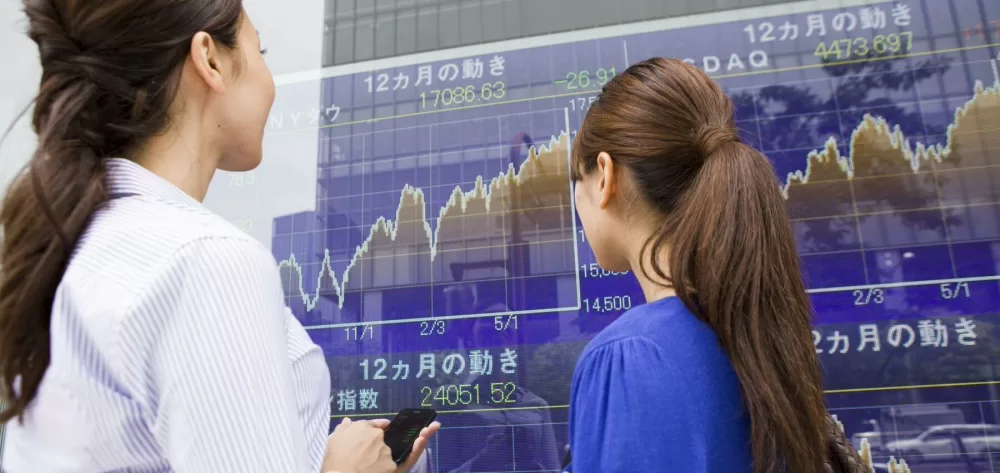Gender is a topic in finance as well. The financial world is dominated by men, and only a small portion of people who invest their money are women. So-called gender lens investing (GLI) aims to reduce the disparities between women and men.
On the one hand, the gender lens is about creating awareness of financial topics among women. The goal is that women woo will invest their money smartly and benefit from returns on market growth.
On the other hand, GLI is also meant to promote gender diversity and equality within companies. The hope is that the new perspectives introduced will result in the creation of new sources of profit and help companies recognize more risks, and earlier. The idea that greater diversity can also have a positive impact on economies has turned GLI into an investment strategy of its own.
Online comparison service moneyland.ch clarifies the different applications of GLI and explains how you can invest with this strategy in this guide.
What is a GLI investment strategy?
GLI is generally viewed as part of the broader category of sustainable investing. When you follow a GLI investment strategy, you invest specifically in companies which fill certain gender-based criteria. The idea is that because these companies promote diversity, investors benefit from unique economic value and corresponding returns.
At the same time, GLI investors also hope that their targeted investments will incentivize economies as a whole to promote equality and diversity. Ideally, GLI investment strategies should also have a positive social effect.
Which GLI criteria are there?
As with sustainable investing in general, GLI too does not have any unified criteria which apply throughout. Financial institutions typically cite these factors as playing a role in their GLI products:
- Diversity: How many women and men does a company employ? Equal proportions or at least an above-average ratio of women is important. Exceptional weight is given to the ratio of women in management.
- Salary difference: The smaller the difference in salaries between women and men, the more suitable a company is for GLI investors.
- Employment conditions: If an employee has to work harder than a fellow employee to get the same salary, you have an unfair situation although there is no difference in salaries. For this reason, many gender lens investors also look at whether men and women enjoy the same work-life balance, for example, and whether parental leave benefits are favorable and fair.
- Additional measures: Companies which implement special measures to promote gender equality can be attractive to GLI investors. For example, a company which prioritizes business partners with diverse workforces or works with suppliers owned by women could be considered to promote gender equality.
- Type of company: Companies whose business is directly related to gender equality, or primarily affects women, are also prioritized by GLI. For example, a company which develops technology for the early recognition of breast cancer may qualify.
- Transparency: In order to be able to consider the above factors, the required information must be available (salary information, for example). For that reason, GLI investors normally expect companies to be as transparent as possible with regards to gender-related information.
How are the criteria applied?
Most investment service providers name some or all of the criteria above as applicable to their GLI products. Unfortunately, details about the methodology used are absent in many cases. That is problematic, considering there are no commonly accepted GLI guidelines. Different financial services providers have different ways of defining, accounting for, and weighting criteria.
As a customer, there is often no clear way to know how high the ratio of women in management must be in order for a company’s stock to be considered for a GLI product. Understanding the concrete reasons why a specific stock is considered to be GLI-eligible is especially difficult. Gender product providers simply state which criteria generally apply.
Additionally, some investment firms also include the stocks of companies even if they only show a trend towards improvement in the gender area. Others buy shares in companies which have good gender marks compared to other companies in their industry sector. These very relative interpretations in no way guarantee that your money is flowing into the most exemplary companies.
Which GLI products are there?
A number of financial products which are marketed as having a positive impact on gender diversity are offered in Switzerland. The majority of these are exchange-traded finds (ETFs) and mutual funds which you can invest in through your bank or online broker.
The selection is still small compared to more general sustainable investment products. Here are some examples:
| Product |
Type |
Issuer |
TER |
ISIN |
| Global Gender Equality |
ETF |
Lyxor |
0.20% |
LU1691909508 |
| SPDR Gender Diversity Index |
ETF |
SSGA |
0.20% |
US78468R7474 |
| Global Gender Equality |
ETF |
UBS |
0.20% |
IE00BDR5H412 |
| Refinitiv Inclusion and Diversity |
ETF |
iShares |
0.25% |
IE00BD0B9B76 |
| Swissquote Gender Equality Index |
Certificate (active) |
Leonteq |
0.25%* |
CH1163993145 |
| Global Gender Equality Equities |
Mutual fund (active) |
Robeco |
0.91% |
LU2145459264 |
| Diversity Plus Aktienfonds |
Mututal fund (active) |
Ampega |
1.07% |
DE000A12BRD6 |
| Elle-XX Gender Equality Basket |
Certificate (active) |
ZKB (for Migros Bank) |
1.10%* |
CH1105885698 |
* Administrative fee (not TER)
Many investment funds marketed as sustainable also claim to account for gender factors. But these are not as focused on GLI as the examples listed in the table above.
How much do GLI products cost?
The ongoing annual costs are shown in the table above. Expect total expense ratios (TERs) between around 0.2 and 1.1 percent. The costs of the more affordable passively-managed products are typically around 0.2 percent.
Transaction costs like stock exchange fees and stamp duties are not normally accounted for in the TER. Separate sales charges may also apply when you buy and/or sell fund shares. If you buy funds through a stock broker, you pay brokerage fees and normally also custody fees.
Are there any Swiss GLI products?
Most of the gender lens investment products available in Switzerland are offered by foreign service providers. However, there are some Swiss financial service providers which offer GLI investment solutions. There are currently no funds which concentrate on the Swiss market.
Swiss stocks are included in a few funds, but the proportion of Swiss stocks in the total fund is very low in each case. The stocks included are all blue chips which are generally found in all Swiss stock funds – including those without any gender focus.
So when you invest in gender-based vehicles, you are investing either mostly or entirely in foreign companies. In the case of global GLI products, particular weight is normally given to US stocks.
Currency is also an important consideration when investing in these funds. If a fund or other investment product is denominated by the US dollar or the euro, then you should account for currency exchange risk, and be aware that additional currency exchange costs may apply when you invest.
Are funds the only way to invest in gender diversity?
Funds are the conventional way. Alternatively, the Elle-XX equality platform launched by journalist Patrizia Laeri has offered its own tracker certificate for a while now. This certificate is managed by the Migros Bank and issued by the Zürcher Kantonalbank (ZKB). It is relatively expensive, with ongoing administrative fees equal to 1.1 percent of the amount invested. That is high compared to passively-managed funds. Even some actively-managed GLI funds are more affordable.
A disadvantage of tracker certificates is that investors are subjected to counterparty risk. Unlike funds, certificates do not fall under the Collective Investment Schemes Act (CISA). If the issuer – the ZKB in this case – were to go bankrupt, you could lose your full investment in the worst case. In the case of the Zürcher Kantonalbank, the government of the canton of Zurich accepts liability for the bank’s obligations to depositors. That means you will likely be able to reclaim your money, even if at the expense of taxpayers.
Can I invest in GLI on my own?
Yes, it is perfectly possible to invest directly in companies with exemplary track records for diversity and gender equality. Putting together your own portfolio based on GLI criteria also gives you the opportunity to include more Swiss stocks if you are looking to make a local impact. You may also save money by buying stocks directly through an affordable broker rather than paying an expensive fund to invest for you.
The downside is that you have to research and pick individual stocks yourself – a task you avoid when you invest through funds. When you invest yourself, proper diversification is very important in minimizing the risk of making losses.
Where can I invest in GLI solutions?
You can invest in the GLI funds and/or tracker through stock brokers or through your bank. Not all Swiss brokers offer the same selection of GLI investment solutions. You may find that your stock broker or bank does not offer the ETF which you want. However, you can ask your broker directly whether they can organize the purchase even though the fund is not included as standard in their app or online trading platform.
Alternatively, you can always open an account with a different service provider. Make sure to check whether the product you want is offered before you apply. Also pay attention to the costs. If a broker charges high custody fees, for example, then opening an account just to invest in one fund probably is not worth it.
Are there GLI solutions for the pillar 3a?
Yes, it is possible to invest your pillar 3a assets with a gender focus. Inyova, a Swiss asset management service, lets you select gender equality profile when setting up your investment portfolio. When you select this option, Inyova proposes companies with good gender diversity in management, or salary equality across women and men. It is important to note, though, that there are more affordable Swiss retirement asset management apps than Inyova.
Other services do provide some options for investing pillar 3a assets in sustainable investment solutions. These products normally follow ESG criteria and some also account for gender factors. Special GLI funds are not normally available.
Equality platform Elle-XX also advertises a pillar 3a solution, but this product is in fact the pillar 3a offer from Vontobel, and does not currently have any special focus on gender issues. Furthermore, this pillar 3a solution is expensive compared to many other digital retirement asset management services.
Are other aspects of sustainability accounted for?
Most GLI products also consider other sustainability criteria in addition to gender. For example, the stocks of companies which earn money from the production of weapons or fossil fuels are explicitly excluded in many cases.
However, the exclusions are not always as strict as conscientious investors may want them to be. For example, a gender product may include companies such as fossil fuel vehicle manufacturers.
If you want to account for factors other than gender, you may find that the available GLI funds do not fully suit your needs. That is why it is important for you as an investor to review the products carefully and ask for more information if necessary.
Are GLI products primarily designed for women?
No. Men can also invest their money in a way that promotes equality. Both women and men can invest in gender funds and trackers.
In practice, gender products are often marketed specifically to women. That approach matches the gender lens goal of encouraging women to invest their money and profit from returns.
Does gender lens investing make a difference?
The exact social impact of GLI is difficult to measure. Investors are just one of many factors which determine gender diversity. But it is generally safe to assume that the increasing focus on gender in the financial world is making a difference. According to a report by Heidrick & Struggles, pressure from investors is partially responsible for the drastic worldwide increase in women CEOs which occurred in 2021 – following a drop during the coronavirus pandemic.
Because of the many different applications used by different service providers, there are likely to be big differences in the impact of different products. The SPI Gender Equality index from SIX, for example, only lists companies in which at least 20 percent of directors on the board are women. According to a study by CRIF, the average ratio of women on the boards of Swiss companies has sat at more than 20 percent for ten years now. So a company only has to have an average ratio to be included in the index.
Another consideration is that large, public Swiss companies are required to implement a legally stipulated gender quota by 2031. By that time, women must make up at least 30 percent of each board of directors. So whether investment products with lower requirements than that can make a meaningful contribution to social improvements is questionable.
Although the direct link between your investments and actual social change is often difficult to define, GLI does offer an advantage: You deliberately support companies which share your values, regardless of whether or not that results in social changes. In that sense, GLI products do the same thing that sustainable investments do, in that they let you build your wealth with a clear conscience.
Does GLI pay off financially?
Theoretically, greater diversity should contribute to better recognition of potential risks and business opportunities, which is an economic advantage. But whether or not GLI pays off in practice remains a topic of discussion in the financial world. Many of the GLI products on the market are relatively new, and historical performance does not provide clear answers.
In every case, you can optimize your returns by minimizing your investment costs. Whenever possible, choose investment products with low ongoing costs and low sales charges (or none at all). The general rule is: Actively managed funds normally do not pay off, because their performance is rarely enough to justify their higher costs. You can potentially save even more by buying the stocks directly using a cheap online broker, instead of investing through a fund.
How can I find the right gender lens investment solution?
Because of the many different approaches taken by service providers, many would-be investors have difficulty choosing a suitable GLI solution. For example, a gender fund may include a company which does not meet your standards for equal salaries.
As an investor, you have to chase the service provider yourself if you want to find out how their product actually promotes gender equality in practice. Depending on how specific your personal GLI demands are, putting together your own gender portfolio can make more sense than using existing funds.
How risky is gender lens investing?
Many GLI products are labelled as higher risk by their issuers. This is largely because they are pure stock funds. These generally require an investment horizon of at least ten years. The longer you will hold the investment, the lower the risk of investing in stock funds is.
As an investor, you should pay attention to the diversification of your investments. Normally, the canned GLI products offered by service providers are already broadly diversified across different industries and countries. But there are also funds which, for example, only invest in US companies. If you were to only invest in that fund, your wealth would be more heavily dependent on the US economy than if you also used a fund which invests in European stocks.
Many GLI products concentrate entirely on blue chip companies, or only include relatively few different stocks. If you only invest with a solution like this, your portfolio may not be sufficiently diversified.
You can reduce your risk by investing in several different GLI products instead of just one. In this case, you must make sure not to use two products with very similar components. There are also many sustainable funds and ETFs which account for some aspects of gender equality. You can use these to diversify your portfolio.
More on this topic:
Tips for investing in sustainable funds
Guide to sustainable funds
Online trading compared


 Deal of the Day
Deal of the Day 





